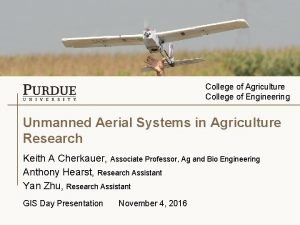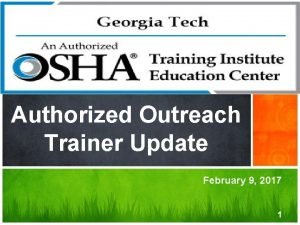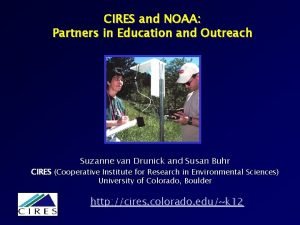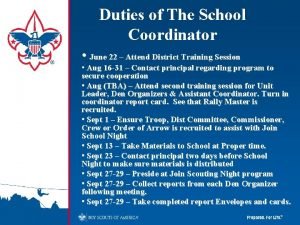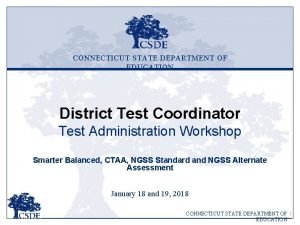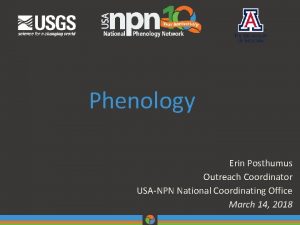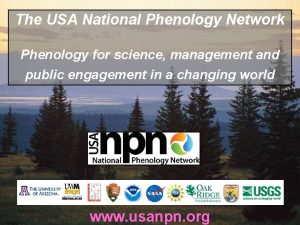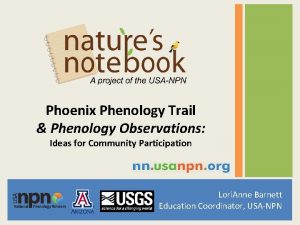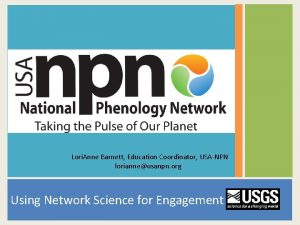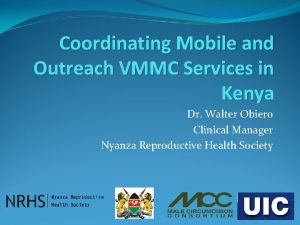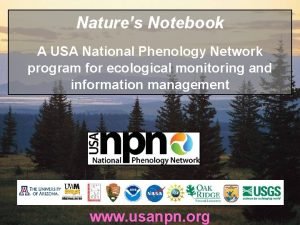Phenology Erin Posthumus Outreach Coordinator USANPN National Coordinating


















































- Slides: 50

Phenology Erin Posthumus Outreach Coordinator USA-NPN National Coordinating Office February 2017


What is phenology? From the Greek phainō meaning "to show, to bring to light, make appear" Photos: Brian F Powell Recurring plant and animal life cycle stages and their timing and relationships with climate and other abiotic factors

September – Harvest Moon May – Flower Moon November Beaver Moon Photo Credits: Wikimedia Commons www. farmersalmanac. com/full-moon-names/ February – Worm Moon Photo credit: B. Powell Phenology is nature’s calendar

Tradition and lore Harvest corn when oak leaves are the size of a mouse’s ear Once lilac flowers have faded, plant squash and cucumbers. When crabapple and wild plum are at budbreak, eastern tent caterpillars are hatching

“Phenology, in short, is a ‘horizontal science’ which transects all ordinary biological professions. Whoever sees the land as a whole is likely to have an interest in it. ” Aldo Leopold

Photos: Brian F Powell, Erin E Posthumus

Why is phenology important? • Health • Resource management • Conservation • Agriculture • Understanding hazards • Recreation

Phenology as an indicator Photos: Brian F Powell “Phenology…is perhaps the simplest process in which to track changes in the ecology of species in response to climate change. ” (IPCC 2007)

Phenology Shifts • Shift in timing of flowering (Bowers 2007, Inouye 2008, Kimball et al. 2009, Crimmins et al. 2011) • Timing of migratory bird arrivals (Mc. Kinney et al. 2012, Kellermann in prep) • Timing of egg laying (Brown et al. 1999) • Timing of animal emergence (Inouye et al. 2000, Forister & Shapiro 2003, Ozgul et al. 2010)

Proximate and ultimate goals

Basic Needs: Light Water Air Nutrients Phenology Drivers: Temperature Daylength Chilling period Pollination Spread of seeds Quercus robur

Phenology Drivers: Nutrients Air Shelter Temperature Young oak leaves Operophtera brumata Photo: Winter moth caterpillar © Milan Zubrik, Forest Research Institute, Slovakia, Bugwood. org Basic Needs:

Basic Needs: Nutrients Air Shelter Phenology Drivers: Daylength Food for nestlings Ficedula hypoleuca

Phenological Mismatch Both et al. 2006 Nature nadiah. org/phenology. html


Broad-tailed hummingbird, Photo: Tom Grey 2012. Mc. Kinney, et al

Broad-tailed hummingbird, Photo: Tom Grey 2012. Mc. Kinney, et al

Sonoran Desert 1980 s Aug Sep Oct Nov Dec Jan Feb Mar Apr May 2000 s Cold-adapted plants Aug Sep Oct Nov Dec Jan Feb Mar Apr May 2010. Kimball et al

Finger Rock Trail t n 0 20 m tio a v ele n die a gr 1 2009. Crimmins et al

Finger Rock Trail 25 years later, 93 of 363 plants shifted t n 0 20 m tio a v ele n die a gr 1 2009. Crimmins et al

Southwest phenology = it’s complicated Predicted Southwest climate changes: • Warmer • Precipitation harder to predict • Longer growing seasons? • More extreme heat events • Freezes still possible Take home: we need more data!

Introduction to Citizen Science

What is citizen science? Also known as: • crowd science • crowd-sourced science • civic monitoring • volunteer monitoring • networked science • participatory monitoring/research Photo: Brian F Powell Scientific research conducted, in whole or in part, by amateur or nonprofessional scientists

Known by other names throughout history Great increase in programs in the 1990 s – why? Term first entered into Oxford English Dictionary in 2014 Photo: Albert Herring, Wikimedia commons History of citizen science

Jefferson Powell Thoreau Leopold-Bradley Photos: Thoreau Powell, images from the National Portrait Gallery, Washington, Nina Leopold Bradley photo from Journal Sentinel files, Jefferson portrait by Rembrandt Peale Early citizen scientists

The increasing prevalence of citizen science Dramatic growth between 1997 to 2014 in publications featuring citizen science Follet and Strezov 2015, PLo. S ONE

The value of citizen science

The value of citizen science www. epa. gov/climatechange/science/indicators/ecosystems/bird-ranges. html

The value of citizen science “Quality of data collected by volunteers, on a project-byproject basis, has generally been found as reliable as the data collected by professionals" Cooper et al 2014, PLo. S ONE Photo: Brian F Powell Significance of citizen science to research greater than perceived

The value of citizen science Theobald et al 2015, Biological Conservation Photo: Brian F Powell Volunteers contribute ~$2. 5 B annually to biodiversity research

Flowering plants 7 da y av erag e 2012. Primack, R. B, Miller-Rushing, A. J Sandhill crane and geese 2 -3 w e ek ave rage 61 years 1999. Bradley, N. L. , Leopold, C. A. , Ross, J. , Huffacker, W. Photos: Brian F Powell, Thoreau image from the National Portrait Gallery, Washington, Nina Leopold Bradley photo from Journal Sentinel files The value of citizen science

Introduction to USA-NPN and Nature’s Notebook

What is USA-NPN all about? Collect • Store • Share • Advancing Science • Informing Management • Communicating & Connecting Photos: Brian F Powell phenology data & information

How are we structured? Data Products Non-standard or Historical data National Phenology Database USA-NPN Standard Protocols

How do we get the data? A multi-taxa, national-scale plant and animal phenology observation program

How do we get the data? 7, 800+ active observers 8, 400+ active sites 8. 2 M+ records* *As of Spring 2016

How do we observe phenology? Observable life cycle events or PHENOPHASES ANIMAL Activity Reproduction PLANT Leaves Flowers Development Fruits

Types of Phenology Data Collected Activity Reproduction Event Status & Abundance Day of year Development

Nature’s Notebook: Protocols Standardized protocols for 878 plant and 338 animal species* *As of Winter 2017

Nature’s Notebook: Interface Paper datasheets and a web browser OR mobile apps

Nature’s Notebook: Training Resources online and in print, including a one-hour training course

Nature’s Notebook: Data Visualization Personalized phenology calendars and tools for data exploration of all data in the National Phenology Database

Data freely available for download www. usanpn. org/results/data

Nature’s Notebook: Quality Control Quality assurance – for the data coming in Quality control – for the data in the National Phenology Database Available at www. usanpn. org/pubs/reports

Where do the data go?

What we’ve learned so far from Phenology observations help manage invasive species (Wallace et al. 2016, Chapman et al 2014) Warmer winters affect timing of spring leaf out in plants (Fu et al. 2015, Mazer et al 2015) Daytime temperatures - rather than nighttime - trigger leafing in temperate plants (Piao et al 2015) Springs are arriving earlier (Allstadt et al 2015) and the growing season is getting longer (Yue et al 2015) and more! Visit www. usanpn. org/nn/vignettes.

Photos: Brian F Powell Join us!

Tucson Phenology Trail

Questions? Contact erin@usanpn. org or lorianne@usanpn. org
 Usa national phenology network
Usa national phenology network Phenology
Phenology Phenology definition
Phenology definition National collaborative outreach programme
National collaborative outreach programme Phytel appointment reminder
Phytel appointment reminder Outreach program
Outreach program Sam nelson content
Sam nelson content Community health education outreach programs
Community health education outreach programs Sparks nevada police department
Sparks nevada police department Ppn admin cbo
Ppn admin cbo Gulf coast center angleton texas
Gulf coast center angleton texas Nesac outreach facility
Nesac outreach facility Side rails ppt
Side rails ppt Hpd mental health division
Hpd mental health division Objektif program
Objektif program Research outreach predatory
Research outreach predatory Afman 65-605
Afman 65-605 Georgia tech oti
Georgia tech oti Needle exchange belfast
Needle exchange belfast Cires education and outreach
Cires education and outreach Pch outreach program
Pch outreach program White coordinator step
White coordinator step Ken nathens
Ken nathens Xctu coordinator
Xctu coordinator School wins coordinator duties and responsibilities
School wins coordinator duties and responsibilities Shep
Shep Define uu
Define uu How does a light sensor work
How does a light sensor work Ct portal tide
Ct portal tide Chamberlain fnp practicum
Chamberlain fnp practicum Test coordinator
Test coordinator District data coordinator
District data coordinator Incident and problem management definition
Incident and problem management definition Compilation of work in work immersion
Compilation of work in work immersion Home creations ltd is a well known
Home creations ltd is a well known Army sponsorship program
Army sponsorship program Pe action plan
Pe action plan Stroke coordinator boot camp
Stroke coordinator boot camp Fda district recall coordinator
Fda district recall coordinator West lafayette campus title ix coordinator
West lafayette campus title ix coordinator Kteh schedule
Kteh schedule Class coordinator
Class coordinator Physical activity and nutrition coordinator
Physical activity and nutrition coordinator What does a transition coordinator do
What does a transition coordinator do Ricas practice test math
Ricas practice test math Certified hospital emergency coordinator
Certified hospital emergency coordinator Naplan locked down browser
Naplan locked down browser Lcif program
Lcif program Nspcc schools coordinator
Nspcc schools coordinator Atomatoeflames
Atomatoeflames Lcif grant application form
Lcif grant application form

